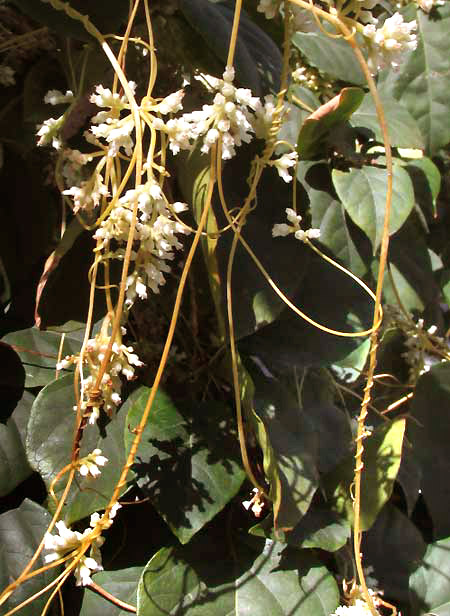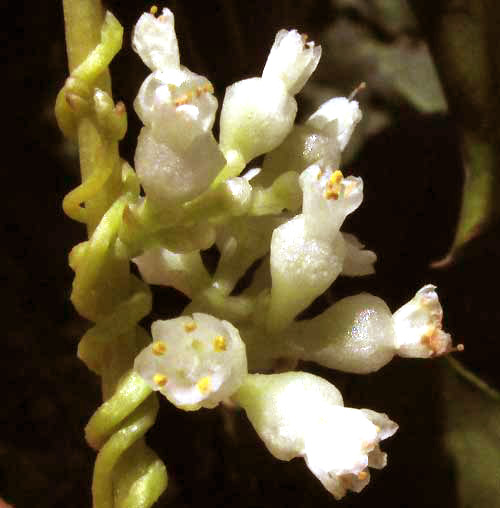Excerpts from Jim Conrad's
Naturalist Newsletter
from the February 14, 2016 Newsletter issued from Hacienda Chichen Resort beside Chichén Itzá Ruins; limestone bedrock; elevation ~39m (~128ft), N20.675°, W88.569°; central Yucatán state, MÉXICO
DODDER ON BOUGAINVILLEA VINES
In Valladolid I found a Bougainvillea vine with dodder on it, shown below:

Our Bougainvillea page is at www.backyardnature.net/yucatan/bougain2.htm.
In our picture, the dodder is the stringy, yellowish, thread-like stems with clusters of tiny white flowers attached; the green leaves belong to the Bougainvillea. Dodder stems lack green leaves and their stems also lack green chlorophyll because dodders are parasites that rob nutrients and sap from their host and don't need to photosynthesize their food. Below, a close-up of some flowers showing erect petals atop spherical, white, capsular fruits:

Dodder species often attack only a narrow range of hosts. Bougainvillea is a much-loved ornamental woody vine from South America abundantly planted here and in the tropics and sub-tropics the world over, so a dodder species parasitizing it probably either specializes in the family to which Bougainvillea belongs, the Four-O'clock Family, the Nyctaginaceae, or else it's a species capable of attacking a wide variety of hosts.
To identify this dodder species, first I Googled for dodder species known to infect members of the Four-O'clock Family. Nothing turned up, so went to the list of twelve dodder species -- members of the genus Cuscuta of the Morning Glory Family -- listed for the Yucatan at the web site of the Center of Scientific Investigation of the Yucatan, CICY.
Dodders usually are hard to identify not only because they lack leaves to help with the identification, and the flowers are so tiny, but also because Cuscuta taxonomy is a mess.
Still, by matching our pictures of flowers with those of Yucatan species shown on the Internet, I'm about 80% sure that our Valladolid species is CUSCUTA CORYMBOSA var. STYLOSA. Here are the main features noted:
# the flowering heads consist of a small number of loosely clustered blossoms
# the sepals are membranous with rounded tips
# the corolla persists atop the maturing capsules, holding its lobes erect
# the corolla lobes are only about ¼th the length of the corolla tube
# growing on introduced Bougainvillea suggests that it's a species capable of infesting many kinds of plants, which is exactly the case with Cuscuta corymbosa
Cuscuta corymbosa, which doesn't seem to have its own English name, is thought to be native to Central America, but as a parasitic weed it's invaded as far north as Mexico and as far south as Peru.